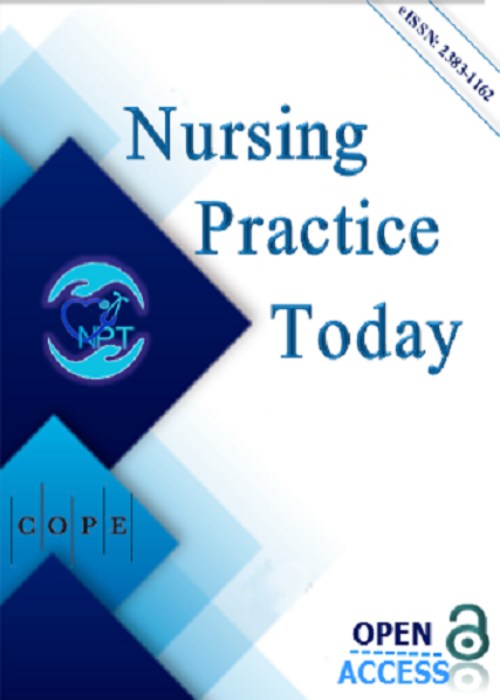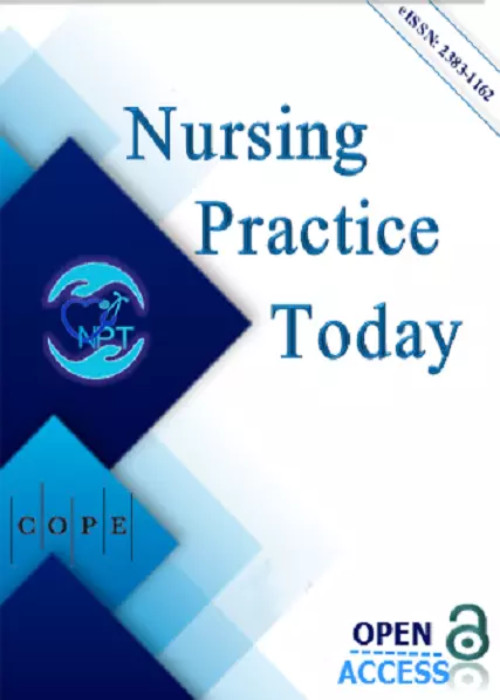فهرست مطالب

Nursing Practice Today
Volume:10 Issue: 2, Spring 2023
- تاریخ انتشار: 1402/03/06
- تعداد عناوین: 10
-
-
Pages 86-98Background & Aim
Providing adolescents with information to understand their sexual health is critical to promote healthy sexual development, reducing the negative consequences of risky sexual behaviors, and creating a foundation for healthy adulthood. This study aimed to identify the recent empirical evidence on new methodologies for improved sexual health outcomes among adolescents.
Methods & Materials:
A systematic review of randomized controlled trials guided the PICO question, "What knowledge and attitudes do high school students obtain when confronted with new methodologies for teaching sexuality compared to traditional teaching?" regardless of geographic location, race/ethnicity, or gender criteria, concerning adolescents, was conducted. The databases CINAHL, MEDLINE, PsycINFO, SCOPUS, and Cochrane Central Register of Controlled Trials, were searched in December 2022. The Joanna Briggs Institute Critical Appraisal tools for use in JBI Systematic Reviews were used to assess methodological quality. Data were synthesized across studies and presented narratively.
ResultsThirteen articles were included for review, involving 11.262 participants. The duration of the interventions with new methodologies ranged from a few hours to three months. New methodologies on sexual health education to improve high school student's knowledge and attitudes were divided into four types: digital and Internet-based intervention, curriculum-based intervention, training-based intervention, and peer group bonding-based intervention.
ConclusionThese results provide healthcare professionals with additional strategies that may be integrated into school health programs regarding sex education.
Keywords: sexual health, sex education, adolescent, knowledge, attitudes -
Pages 99-107Background & Aim
Mechanical ventilation is a life-saving method for acute respiratory distress syndrome. The present study aimed to investigate the impact of airway pressure release ventilation-low tidal volume mode on COVID-19 patients’ peripheral capillary oxygen saturation and ventilation indices.
Methods & Materials:
This clinical trial was conducted on 70 COVID-19 patients hospitalized in the Intensive care unit in Qom, Iran. Patients were selected using convenience sampling and randomly allocated to intervention and control groups. In the control group, patients were ventilated using synchronized intermittent mandatory ventilation mode, and in the intervention group, patients were ventilated using airway pressure release ventilation-low tidal volume mode. Patients’ peripheral capillary oxygen saturation and ventilation indices were checked and recorded before and after the intervention. The data were analyzed using SPSS 11.5.
ResultsAccording to the results of the repeated-measures ANOVA test before the intervention and the 2 and 4 hours after the intervention, there were no significant differences between the intervention and control groups regarding the fraction of inspired oxygen, volume minute per minute, and peripheral capillary oxygen saturation (P>0.05). However, in the intervention group compared to the control group, the mean of PIP was significantly reduced (P<0.05).
ConclusionIn patients with COVID-19, the two modes of mechanical ventilation, APRV, and control, had no significant differences in the fraction of inspired oxygen, volume minute per minute, and peripheral capillary oxygen saturation. However, the mean peak inspiratory pressure reduction in the intervention group was greater than that in the control group. Considering that several factors can affect peripheral capillary oxygen saturation and ventilation indices, these results should be considered with caution.
Keywords: respiratory distress syndrome, COVID-19, artificial respiration, oxygen saturation, respiratory insufficiency -
Pages 108-123Background & Aim
The trans-theoretical model suggests that stage-matched interventions improve the effectiveness of behavior changes such as quitting. This study aims to examine the effect of stage-matched smoking cessation educational intervention based on the trans-theoretical model using motivational interviewing on Egyptian males' knowledge, stage movement, and smoking cessation rate.
Methods & Materials:
A randomized controlled trial was conducted in the main building of Damanhour University, Egypt. The participants were selected using simple random sampling (N=165), then allocated to both experimental (N=82) and control (N=83) groups using the randomization block technique. Data was collected using a structured interview schedule. The instrument contained five parts: Personal Characteristics and Smoking data, Fagerstrom Tolerance Questionnaire, Tobacco Cessation Readiness Scale, Smoking Knowledge Scale, and trans-theoretical Model constructs questionnaire. The experimental group received ten months of educational intervention using face-to-face and phone-based motivational interviewing.
ResultsA significantly higher stage movement was revealed among the experimental group post-intervention (80.5%); 35.4% transitioned to the preparation stage, 32.9% were in the action stage, and 12.2% were in the maintenance stage. According to the ANCOVA test, significant negative mean differences post-intervention was achieved for nicotine dependence and decision pros (P=0.000) with a large effect size (η2=0.341, η2=0.503). However, significant positive mean differences were proved for other variables (knowledge, tobacco cessation readiness, and TTM constructs) (P<0.05) with a large effect size (η2>0.14). Stage analysis revealed significant mean differences in most studied variables, where the action stage had the highest significant mean improvements (P<0.05).
ConclusionThe trans-theoretical model-based educational intervention using motivational interviewing effectively improves smoking knowledge and facilitates quitting with successful stage movement among Egyptian male smokers.
Keywords: transtheoretical model, cigarette smoking cessation, smoking knowledge, nicotine dependence -
Pages 124-137Background & Aim
The outbreak of the COVID-19 pandemic has disrupted healthcare systems. Nurses were deeply affected physically, psychologically, and socially. This study was conducted to examine the experiences and perceptions of intensive care nurses who provide care for patients with COVID-19 during the pandemic process.
Methods & Materials:
This qualitative study was conducted using the content analysis approach. This research was carried out with 11 nurses working in the intensive care unit and caring for COVID-19 patients between May and September 2021. A purposive sampling method was used to include nurses in the study. The data of the research were collected with an eight-question semi-structured interview form and in-depth interview technique. The data were analyzed by using the content analysis method.
ResultsThe six main categories identified in this study were challenging working conditions, tiredness, isolation and loneliness, fear, and helplessness, lack of management support, and expectations and needs.
ConclusionThis study has shown that intensive care nurses who care for COVID-19 patients in Turkey are greatly adversely affected physically, psychologically, and socially by the pandemic process. In this process, it is extremely important to improve the financial and moral support for nurses. Policymakers and managers should try to reduce the physical, psychological, and social impacts of the pandemic on nurses by focusing on their experience and taking appropriate action.
Keywords: COVID-19, intensive care units, nursing experience, qualitative studies -
Pages 138-146Background & Aim
Napping is one of the evidence-based countermeasures to fatigue and decreased alertness during night shift work. We aimed to understand night shift nurses' napping practices and study the effectiveness of different nap lengths on sleepiness, fatigue, well-being, and the quality of nursing care.
Methods & Materials:
A comparative descriptive design was used. Data were self-reported by 305 nurses using the Questionnaire on Night Shift Napping Practices, the Karolinska Sleepiness Scale, the Fatigue Visual Analog Scale, the Everyday Feeling Questionnaire, and the Quality of Nursing Care Questionnaire. Data collection was done over 4 months between August and November 2022. Frequency tables, Mean, and standard deviation were used to describe data, and One-way analysis of variance (ANOVA) was used for means comparisons.
ResultsAbout 40% of the nurses reported that they took naps during their night shifts. The majority (82.92%) reported that they napped for more than 45 minutes (N= 305). Napping was found to significantly reduce sleepiness (P= 0.002) and fatigue (P= 0.001) and improve the quality of nursing care (P= 0.03). The group who napped for more than 45 minutes reported significantly reduced levels of sleepiness (P= 0.02) and fatigue (P= 0.01) when compared to the group who either didn’t nap or napped for less than 45 minutes.
ConclusionThis study suggests that implementing nap interventions for nurses on night shift can be an effective method to reduce sleepiness and fatigue, and improve patient care.
Keywords: fatigue, nurses, psychological well-being, shift work, sleepiness -
Pages 147-155Background & Aim
The incidence of near-death experience is not a novel phenomenon since human history. However, with healthcare technological advancement, near-death narratives have been reported in a greater number of critically ill patients as well as in the general community. Therefore, healthcare professionals must recognize the concept of near-death experiences and provide relevant care to their patients. Unfortunately, healthcare providers, especially nurses, do not have sufficient knowledge regarding near-death experiences, hence, to clarify the concept and its importance for better patient-care outcomes via this concept analysis.
Methods & Materials:
The understanding of the near-death phenomenon is employed through the framework of Walker and Avant's concept analysis. The study familiarizes the concept via its definition, origin, significance, characteristics, antecedents, and consequences of near-death experiences. This was achieved after deeper exploration and analysis of the concept through an extensive literature search. Furthermore, multiple cases are provided as exemplars to recognize the concept.
ResultsNear-death experience is defined as a profound conscious experience encountered by the individual. The characteristics of near-death experiences are based on cognitive, affective, paranormal, and transcendental components. Following the experience, the individuals undergo a transformational change in their lives. However, individuals with near-death experiences require facilitation and support from healthcare workers, especially nurses, for the early integration of near-death experiences.
ConclusionThe understanding of the concept of near-death experience enables nurses to provide relevant nursing interventions. Such interventions promote positive well-being in the individuals' lives through their near-death experiences.
Keywords: near-death experience, concept analysis, nursing -
Pages 156-163Background & Aim
Adopting self-care behaviors is considered an important factor in the prevention of COVID-19. Therefore, this study was conducted to investigate Self-Care Behaviors Related to COVID-19 among Iranian elderly with and without a history of infection.
Methods & Materials:
This descriptive-correlational study was conducted on 324 elderlies in Iran in 2021. Eligible seniors were selected by convenience sampling and placed into two groups: the elderly with a history of COVID-19 and the elderly without it. The data collection tools included the demographic form and the questionnaire on self-care behaviors during the COVID-19 pandemic. Data analysis was done with SPSS software version 25 using descriptive (frequency and percentage) and inferential statistics (Mann-Whitney u-test and independent t-test).
Results165 men (50.90%) and 159 women (49.10%) participated in this study. The mean age of the participants was 70.60 ± 8.73. The results showed that there was a statistically significant difference between the self-care behaviors of the elderly with a history of COVID-19 and those without it; the elderly with a history of COVID-19 had more favorable self-care behaviors (p<0.001).
ConclusionA history of COVID-19 results in better self-care behaviors. It can be justified by constructs of the health beliefs model, including perceived susceptibility, severity, and treatment. Therefore, it is necessary to improve self-care behaviors by using the experiences of infected elders in health education to influence the above mention constructs.
Keywords: self-care behaviors, elderly, COVID-19 -
Pages 164-172Background & Aim
Nurses worldwide face serious challenges to deal with infectious diseases. A transmission prevention model is expected to be a strategy to overcome these challenges. To date, most of the available models are in the form of disease prevention models primarily implemented to detect infections. In contrast, only a few models are implemented to improve disease transmission prevention behavior, especially in nurses. This study aims to find a model of infection transmission prevention adopted from the aids risk reduction model.
Methods & Materials:
This study was an analytic observational study and employed a cross-sectional approach. This study was conducted in two hospitals in Makassar City and involved 123 respondents. The data were analyzed using multiple linear regression tests.
ResultsThis study finds that there is a correlation between organizational factors and nurses' commitment (b=.268) (p=.003); there is a correlation between self-justification and nurses’ self-labelling as at-risk individuals of contracting the disease (b=-.180 )(p=.049); there is a correlation between labeling and actions to reduce the risk of disease transmission (Enactment) (b=.255)(p=.001); there is a correlation between nurses' commitment and enactment (b=.651)(p=.001).
ConclusionThe risk reduction model could represent the nurses' disease transmission prevention behavior.
Keywords: nurses, disease transmission, risk reduction model, aids risk reduction model


